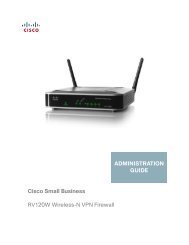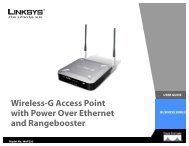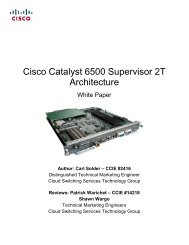Cisco EnergyWise IOS Configuration Guide - Ipland
Cisco EnergyWise IOS Configuration Guide - Ipland
Cisco EnergyWise IOS Configuration Guide - Ipland
Create successful ePaper yourself
Turn your PDF publications into a flip-book with our unique Google optimized e-Paper software.
<strong>Configuration</strong> <strong>Guide</strong>lines<br />
Chapter 2<br />
Configuring <strong>EnergyWise</strong><br />
CLI Compatibility<br />
Note Catalyst 6500 switches do not support <strong>EnergyWise</strong> Phase 1.<br />
To display the <strong>EnergyWise</strong> version running on your domain member, use the show energywise version<br />
privileged EXEC command. The <strong>EnergyWise</strong> version is referred to as the <strong>EnergyWise</strong> specification in<br />
the command output.<br />
To display the software version running on your domain member, use the show version privileged EXEC<br />
command.<br />
Note<br />
If your domain member is running <strong>EnergyWise</strong> Phase 2 or later, enter the no energywise domain global<br />
configuration command to disable <strong>EnergyWise</strong> before downgrading your software to a release<br />
supporting <strong>EnergyWise</strong> Phase 1.<br />
If your domain member is running <strong>EnergyWise</strong> Phase 1 and you upgrade your software to a release<br />
supporting <strong>EnergyWise</strong> Phase 2 or later:<br />
• The <strong>EnergyWise</strong> settings in the running configuration are updated. The domain member sets the<br />
management password as the same domain password in the energywise domain command.<br />
Enter the copy running-config startup-config privileged EXEC command to save the <strong>EnergyWise</strong><br />
settings in the configuration file.<br />
• For <strong>EnergyWise</strong> to work properly<br />
– All domain members must run <strong>EnergyWise</strong> Phase 1 or <strong>EnergyWise</strong> Phase 2 or later.<br />
– All domain members must have the same domain name and security mode.<br />
– If your switch is stacking-capable (for example a Catalyst 3750-X, 3750-E, or 3750 switch) and<br />
is a member of a switch stack, all the stack members must run the same <strong>EnergyWise</strong> version.<br />
In <strong>EnergyWise</strong> Phase 1 these commands were modified:<br />
• energywise domain domain-name secret [0 | 7] password global configuration command<br />
We recommend that you reconfigure the <strong>EnergyWise</strong> domain with the energywise domain<br />
domain-name security {ntp-shared-secret | shared-secret} [0 | 7] shared-secret [protocol udp<br />
port udp-port-number [interface interface-id | ip ip-address]] global configuration command.<br />
If you do not reconfigure the domain, the domain member synchronizes the management password<br />
with the the domain password.<br />
• energywise management tcp-port-number global configuration command<br />
We recommend that you reconfigure the management password for the domain with the energywise<br />
management security shared-secret [0 | 7] shared-secret port tcp-port-number global<br />
configuration command.<br />
For Catalyst 4500-specific issues, see Appendix A, “<strong>Cisco</strong> <strong>EnergyWise</strong> and Catalyst 4500 Switches.”<br />
For Catalyst 6500-specific issues, see Appendix B, “<strong>Cisco</strong> <strong>EnergyWise</strong> and Catalyst 6500 Switches.”<br />
2-4<br />
<strong>Cisco</strong> <strong>EnergyWise</strong> <strong>Configuration</strong> <strong>Guide</strong><br />
OL-19806-04

















